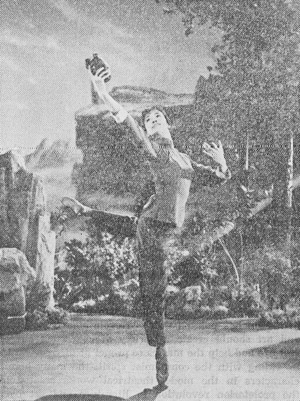|
 |
|
Ying Sao giving her own milk to the wounded PLA soldier |
A dance-drama of medium length with the Chinese People's War of Liberation (1946-49) as its background, Ode to the Yimeng Mountains depicts how a peasant woman in the revolutionary base area of the Yimeng Mountains in Shandong Province saves the life of a wounded soldier of the People's Liberation Army (PLA).
Drawing on the experience gained in creating the model revolutionary theatrical works, it has successfully brought out in its unique, terse and penetrating way the theme of unity between the army and the people. A colour film of this dance-drama is on show throughout the country.
The time is the autumn of 1947 when the PLA had switched from strategic defence to strategic offensive in the War of Liberation. In their last-ditch struggle, the Kuomintang reactionaries massed a large force and hurled it at the Yimeng Mountains base area. In order to completely wipe out the invading enemy, the PLA took the initiative and effected a temporary strategic retreat. Meanwhile, under the leadership of the Communist Party and with the support of the masses, the local armed forces and the people's militia persisted in their valiant struggle against the reactionaries until final victory.
When the curtain goes up, a despotic landlord and a band of armed thugs under him are scouring a mountain village for a wounded PLA platoon leader. A peasant woman named Ying Sao found him lying unconscious in a bush, dying of thirst. Unable to find water anywhere, she feeds him with milk from her own breast. When he comes to, she leads him to a cave where he takes shelter. Defying the white terror then on the rampage, she brings him food and helps him recuperate.
The enemy continues with the search. Ying Sao is subjected to torture and cross-examination. She is being shadowed and threatened with the killing of her unweaned baby. She withstands the ordeal, remains unyielding and carries on the struggle with resourcefulness and courage until a contingent of Party-led armed peasants fought back and wiped out the landlords' armed thugs. The red sun shining over the mountain village, the platoon leader, now fully recovered, rejoins his units and returns to the front, taking with him the deep love of the villagers for the PLA.
Portrayal of heroic images
To create prototypes of proletarian heroes is a fundamental task of socialist literature and art. Chairman Mao has pointed out: "Revolutionary literature and art should create a variety of characters out of real life and help the masses to propel history forward." Sparkling with the communist spirit, the many heroic characters in the model theatrical works created in the proletarian revolution in literature and art over the past decade or so have set examples for the nation's millions to follow in carrying out socialist revolution and construction. The choreographers of Ode to the Yimeng Mountains have succeeded in designing dance movements based on the people's actual struggles and used to advantage music, stage decor and other artistic means to delineate with finesse and profundity the images of the peasant woman Ying Sao and platoon leader Fang - the former a fine representative of the local inhabitants and the latter a typical army cadre who cherishes great love for the people and is imbued with the spirit of self-sacrifice.
The heroine Ying Sao who is a poor peasant woman has bitter hatred for the old society and the reactionaries and holds the Communist Party and the people's army dear to her heart. The scene "Saving the Wounded With Milk" is highly expressive of her character; it brings into bold relief one main facet of her fine qualities - her strong love for the people's army and her dedication to the revolutionary cause.
The scene begins with Ying Sao spotting some bloodstains on the ground while she is on her way to the mountains to dig edible wild plants. Tracing the stains to a thicket, she finds the PLA platoon leader Fang lying there unconscious from a serious wound. Ying Sao quickly bandages up the wound and removes the bloodstains so that the enemy will lose track of him. The wounded soldier is dying of thirst, moaning for water in delirium, but there is not a single drop left in his canteen. Ying Sao looks around, but no water is available anywhere in the vicinity. To go home and fetch water up to the mountain is too far and, moreover, it is not safe to leave the wounded soldier alone. In great anxiety she touches her breast and it dawns upon her that her own milk can save her patient. Her worries dispelled, she beams with joy.
| 